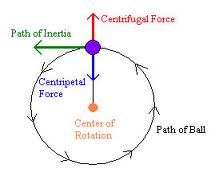This note outlines the two types of forces in circular motion; centripetal force, which is directed towards the centre of the circle, and centrifugal force, which is the opposing force. It is best used in conjunction with the mind map on circular motion.
Pinned to
1274
11
0
No tags specified
|
|
Created by alex.examtime9373
over 11 years ago
|
|
Rate this resource by clicking on the stars below:




 (2)
(2)
Ratings (2)
| 2 | ||
| 0 | ||
| 0 | ||
| 0 | ||
| 0 |
0 comments
There are no comments, be the first and leave one below:
Close
489919
note
2016-12-13T00:31:24Z
1/1
Centripetal Force
- The force that makes a body follow a curved path, i.e. maintain uniform circular motion
- The direction of this force is always towards the centre of the circle
- Vector quantity
- Unit = newton
F = mω²r
- F = centripetal force
- m = mass of the body
- ω = angular velocity
- r = radius of rotation
F = mv²/r
- F = centripetal force
- m = mass of the body
- v = linear velocity
- r = radius
Examples of Centripetal Forces
- Car turning a corner = friction
- Planet orbiting the sun = gravity
- Object twirling on a string = tension
- All of these forces are centripetal and act towards the centre of the circular path
- Without a centripetal force, circular motion does not occur
Centrifugal force
- For every action there is an equal and opposite reaction, according to Newton's third law of motion
- So, centripetal force must have an opposing force keeping the balance, making sure the object is maintained in circular motion
- Centrifugal force balances out the centripetal force when an object is in circular motion
- The direction of the centrifugal force is away from the centre of the circular path
- Centrifugal force is the force that you feel when you are on a roller coaster, and if you weren't strapped in, this force would propel you from the seat.

New Page
